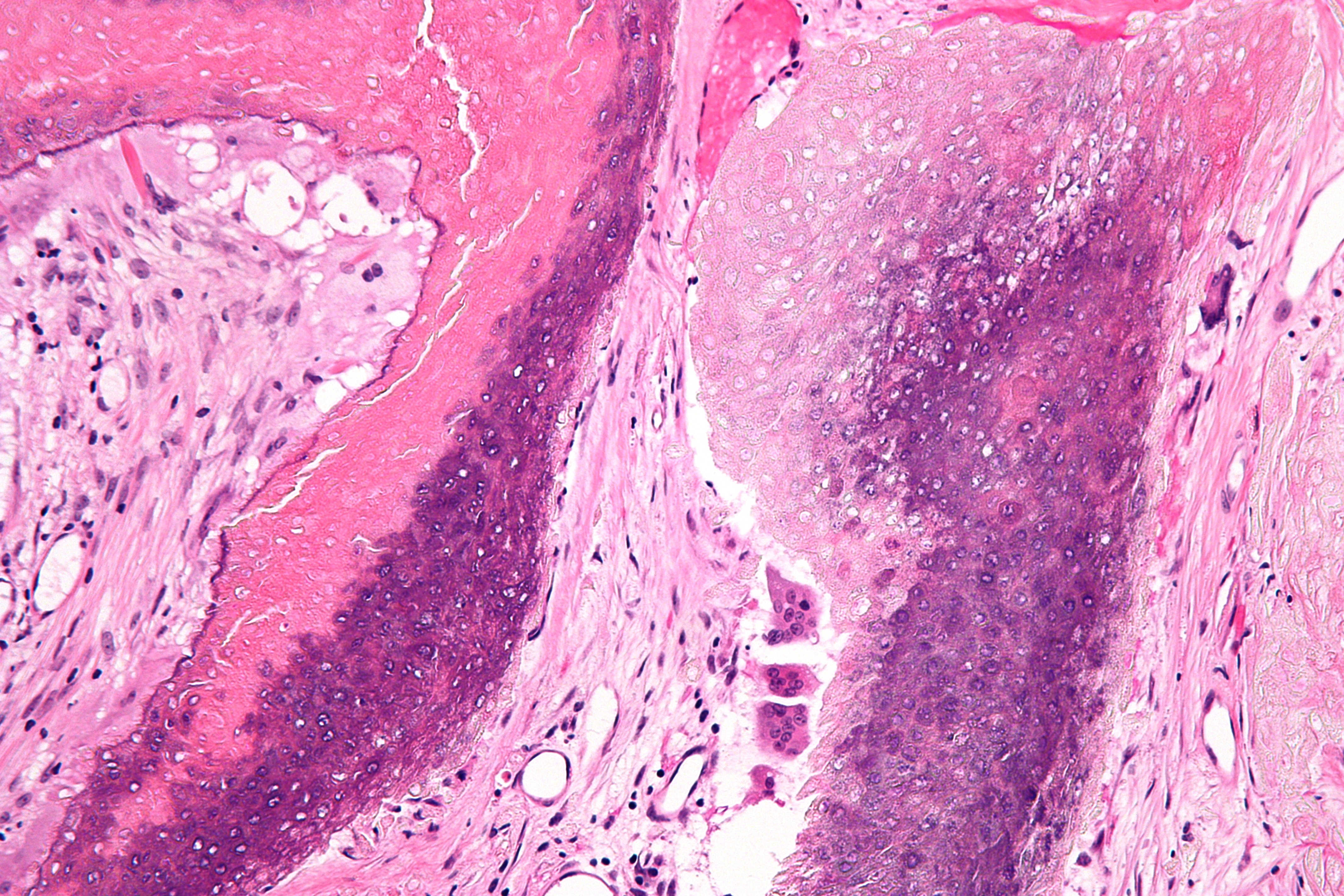Pilomatricoma on:
[Wikipedia]
[Google]
[Amazon]
Pilomatricoma, is a benign
 The characteristic components of a pilomatricoma include a ''stroma'' of fibrovascular connective tissue
surrounding irregularly shaped, lobulated islands containing ''basaloid cells'' (being darkly stained, round or elongated, with indistinct cell borders and minimal cytoplasm, with nuclei being round to ovoid, deeply basophilic and generally prominent nucleoli), which abruptly or gradually transitions into ''ghost cells'' (having abundant, pale, eosinophilic cytoplasm, well defined cell borders and a central clear area, but only faint traces of nuclear material), which in turn may transition into keratinaceous to amorphous ''necrosis''.
The presence of calcifications with foreign body giant cells is common within the tumors.
The characteristic components of a pilomatricoma include a ''stroma'' of fibrovascular connective tissue
surrounding irregularly shaped, lobulated islands containing ''basaloid cells'' (being darkly stained, round or elongated, with indistinct cell borders and minimal cytoplasm, with nuclei being round to ovoid, deeply basophilic and generally prominent nucleoli), which abruptly or gradually transitions into ''ghost cells'' (having abundant, pale, eosinophilic cytoplasm, well defined cell borders and a central clear area, but only faint traces of nuclear material), which in turn may transition into keratinaceous to amorphous ''necrosis''.
The presence of calcifications with foreign body giant cells is common within the tumors.
skin
Skin is the layer of usually soft, flexible outer tissue covering the body of a vertebrate animal, with three main functions: protection, regulation, and sensation.
Other animal coverings, such as the arthropod exoskeleton, have different de ...
tumor derived from the hair matrix. These neoplasms are relatively uncommon and typically occur on the scalp, face, and upper extremities. Clinically, pilomatricomas present as a subcutaneous nodule or cyst with unremarkable overlying epidermis that can range in size from 0.5 to 3.0 cm, but the largest reported case was 24 cm.
Presentation
Associations
Pilomatricomas have been observed in a variety of genetic disorders includingTurner syndrome
Turner syndrome (TS), also known as 45,X, or 45,X0, is a genetic condition in which a female is partially or completely missing an X chromosome. Signs and symptoms vary among those affected. Often, a short and webbed neck, low-set ears, low hair ...
, myotonic dystrophy
Myotonic dystrophy (DM) is a type of muscular dystrophy, a group of genetic disorders that cause progressive muscle loss and weakness. In DM, muscles are often unable to relax after contraction. Other manifestations may include cataracts, intel ...
, Rubinstein-Taybi syndrome, Trisomy 9
Full trisomy 9 is a lethal chromosomal disorder caused by having three copies (trisomy) of chromosome number 9. It can be a viable condition if trisomy affects only part of the cells of the body (mosaicism) or in cases of partial trisomy (triso ...
, and Gardner syndrome
Gardner's syndrome (also known as Gardner syndrome, familial polyposis of the colon, or familial colorectal polyposis) is a subtype of familial adenomatous polyposis (FAP). Gardner syndrome is an autosomal dominant form of polyposis characterize ...
. It has been reported that the prevalence of pilomatricomas in Turner syndrome is 2.6%.
Hybrid cysts that are composed of epidermal inclusion cysts and pilomatricoma-like changes have been repeatedly observed in Gardner syndrome. This association has prognostic import, since cutaneous findings in children with Gardner Syndrome generally precede colonic polyposis.
Histologic features
 The characteristic components of a pilomatricoma include a ''stroma'' of fibrovascular connective tissue
surrounding irregularly shaped, lobulated islands containing ''basaloid cells'' (being darkly stained, round or elongated, with indistinct cell borders and minimal cytoplasm, with nuclei being round to ovoid, deeply basophilic and generally prominent nucleoli), which abruptly or gradually transitions into ''ghost cells'' (having abundant, pale, eosinophilic cytoplasm, well defined cell borders and a central clear area, but only faint traces of nuclear material), which in turn may transition into keratinaceous to amorphous ''necrosis''.
The presence of calcifications with foreign body giant cells is common within the tumors.
The characteristic components of a pilomatricoma include a ''stroma'' of fibrovascular connective tissue
surrounding irregularly shaped, lobulated islands containing ''basaloid cells'' (being darkly stained, round or elongated, with indistinct cell borders and minimal cytoplasm, with nuclei being round to ovoid, deeply basophilic and generally prominent nucleoli), which abruptly or gradually transitions into ''ghost cells'' (having abundant, pale, eosinophilic cytoplasm, well defined cell borders and a central clear area, but only faint traces of nuclear material), which in turn may transition into keratinaceous to amorphous ''necrosis''.
The presence of calcifications with foreign body giant cells is common within the tumors.
Pathogenesis
Pilomatricoma is associated with high levels ofbeta-catenin
Catenin beta-1, also known as beta-catenin (β-catenin), is a protein that in humans is encoded by the ''CTNNB1'' gene.
Beta-catenin is a dual function protein, involved in regulation and coordination of cell–cell adhesion and gene transcrip ...
caused by either a mutation in the APC gene or a stabilizing mutation in the beta-catenin gene, CTNNB1. High levels of beta-catenin increases cell proliferation, inhibit cell death, and ultimately leads to neoplastic growth.
See also
* Malignant pilomatricoma * List of cutaneous conditions *List of cutaneous neoplasms associated with systemic syndromes
Many cutaneous neoplasms occur in the setting of systemic syndromes.
See also
* List of cutaneous conditions
* List of contact allergens
* List of cutaneous conditions associated with increased risk of nonmelanoma skin cancer
*List of cutane ...
References
External links
{{Tumors of skin appendages Cutaneous congenital anomalies